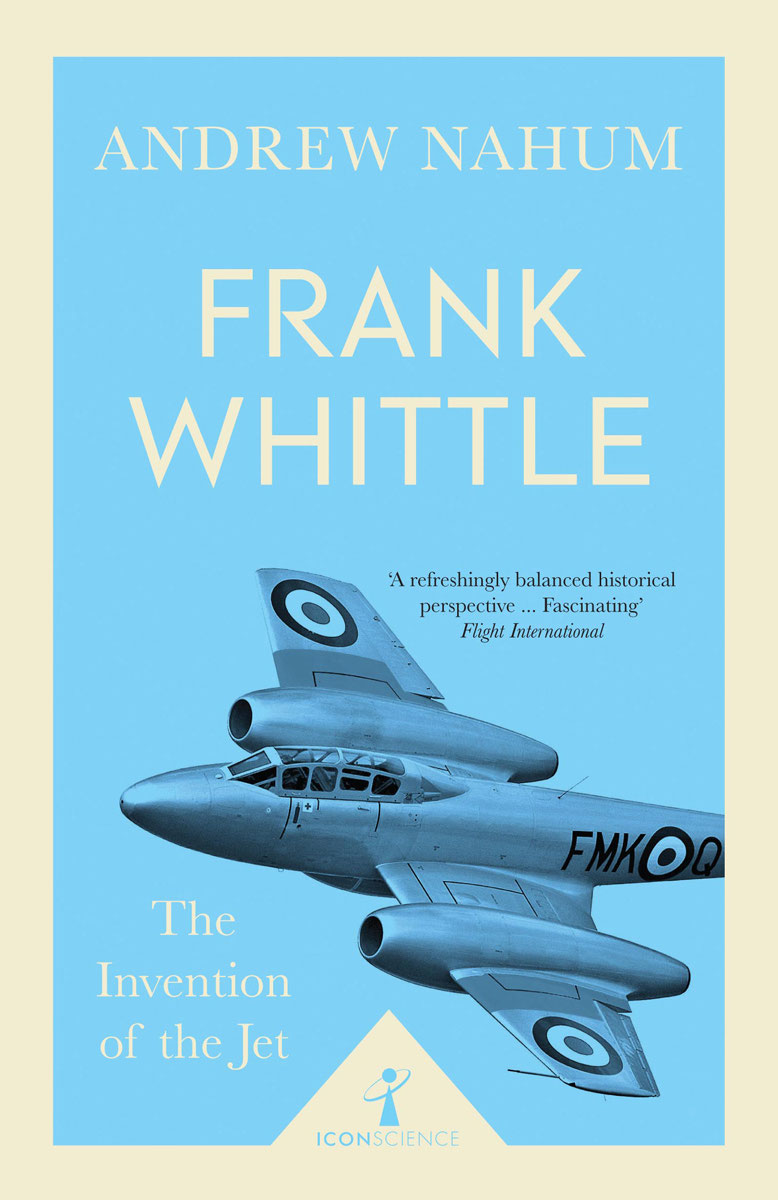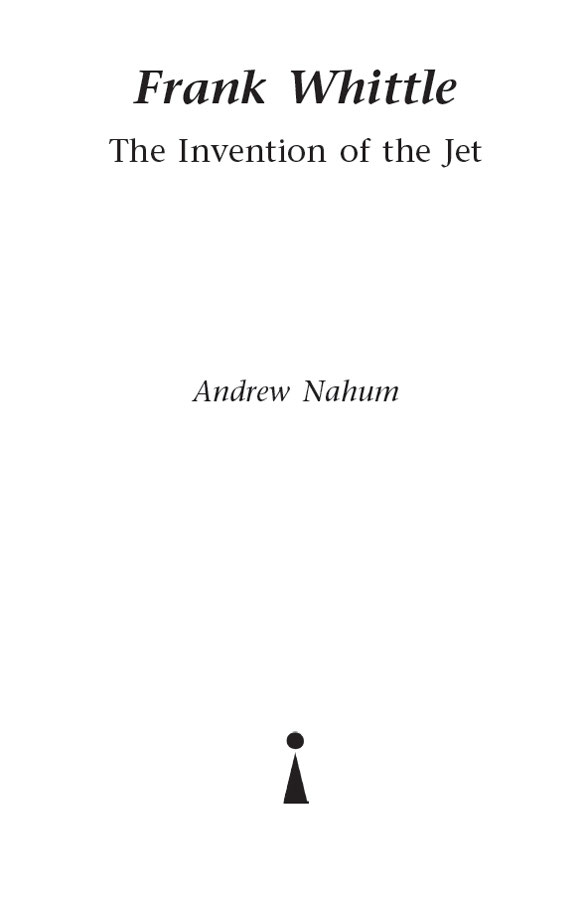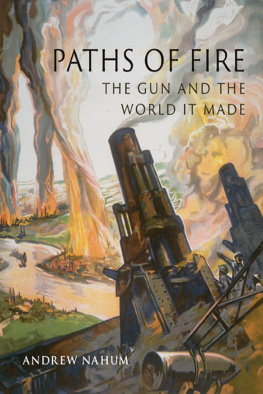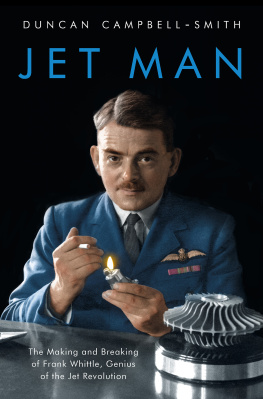Andrew Nahum - Frank Whittle (Icon Science): The Invention of the Jet
Here you can read online Andrew Nahum - Frank Whittle (Icon Science): The Invention of the Jet full text of the book (entire story) in english for free. Download pdf and epub, get meaning, cover and reviews about this ebook. genre: Romance novel. Description of the work, (preface) as well as reviews are available. Best literature library LitArk.com created for fans of good reading and offers a wide selection of genres:
Romance novel
Science fiction
Adventure
Detective
Science
History
Home and family
Prose
Art
Politics
Computer
Non-fiction
Religion
Business
Children
Humor
Choose a favorite category and find really read worthwhile books. Enjoy immersion in the world of imagination, feel the emotions of the characters or learn something new for yourself, make an fascinating discovery.
- Book:Frank Whittle (Icon Science): The Invention of the Jet
- Author:
- Genre:
- Rating:3 / 5
- Favourites:Add to favourites
- Your mark:
- 60
- 1
- 2
- 3
- 4
- 5
Frank Whittle (Icon Science): The Invention of the Jet: summary, description and annotation
We offer to read an annotation, description, summary or preface (depends on what the author of the book "Frank Whittle (Icon Science): The Invention of the Jet" wrote himself). If you haven't found the necessary information about the book — write in the comments, we will try to find it.
Frank Whittle (Icon Science): The Invention of the Jet — read online for free the complete book (whole text) full work
Below is the text of the book, divided by pages. System saving the place of the last page read, allows you to conveniently read the book "Frank Whittle (Icon Science): The Invention of the Jet" online for free, without having to search again every time where you left off. Put a bookmark, and you can go to the page where you finished reading at any time.
Font size:
Interval:
Bookmark:


This edition published in the UK in 2017 by
Icon Books Ltd, Omnibus Business Centre,
3941 North Road, London N7 9DP
email: info@iconbooks.com
www.iconbooks.com
Originally published in 2004 and 2005 by Icon Books Ltd
Sold in the UK, Europe and Asia by
Faber & Faber Ltd, Bloomsbury House,
7477 Great Russell Street,
London WC1B 3DA or their agents
Distributed in the UK, Europe and Asia by
Grantham Book Services, Trent Road,
Grantham NG31 7XQ
Distributed in the USA by
Publishers Group West,
1700 Fourth Street, Berkeley, CA 94710
Distributed in Canada by
Publishers Group Canada,
76 Stafford Street, Unit 300,
Toronto, Ontario M6J 2S1
Distributed in Australia and New Zealand by
Allen & Unwin Pty Ltd, PO Box 8500,
83 Alexander Street,
Crows Nest, NSW 2065
Distributed in South Africa by
Jonathan Ball, Office B4, The District,
41 Sir Lowry Road, Woodstock 7925
ISBN: 978-1-78578-241-1
eISBN: 978-1-78578-256-5
Text copyright 2017 Andrew Nahum
The author has asserted his moral rights
No part of this book may be reproduced in any form, or by any
means, without prior permission in writing from the publisher
Over a number of years I have been very fortunate in being able to talk to a large number of people who were involved in wartime and post-war aeronautical research and development, some, sadly, no longer with us. A number of these were Reactionaries members of the informal association for members of Frank Whittles team at Power Jets while others have been from industry and from the government research establishments. Some are acknowledged directly in the text, although others are anonymous. However I thank them all warmly. Some years ago, the Reactionaries most kindly asked me to their 40th anniversary dinner, held at the wartime headquarters of Brownsover Hall, near Rugby, which started a number of these conversations.
At the Science Museum, my predecessor as Curator of Aeronautics, the late John Bagley, always encouraged my interest in engines and aeronautical history. Through many conversations he also gave an illuminating insight, from his own time as an aerodynamicist at the Royal Aircraft Establishment, Farnborough, into the culture of government defence research and into the relationship between industry and the research establishments.
It would have been impossible to undertake this study without the generous help of the Science Museum, and it is a pleasure to acknowledge the impetus given by Robert Bud, as Head of Research, and Lindsay Sharp as Director. Furthermore, Jon Tucker, Heather Mayfield and Tim Boon have given excellent encouragement.
Special thanks also to Simon Flynn, Jon Turney and Ruth Nelson at Icon Books whose comments and impulsion have helped tremendously.
DEDICATION
For Fiona
Andrew Nahum is a curator, writer and historian. He is Keeper Emeritus at the Science Museum where he led the creation of the landmark gallery Making the Modern World (2000) and many other exhibitions including Inside the Spitfire (2005), Dan Dare and the Birth of Hi-tech Britain (2008) and Churchills Scientists (2015). In 2017 he curated the exhibition Ferrari Under the Skin, at the Design Museum, London.
He has written extensively on the history of technology and on design, and his books include Alec Issigonis and the Mini (Icon Books, 2005), a contribution to the history of British aeronautics in the Cold War, The Royal Aircraft Establishment from 1945 to Concorde in Cold War, Hot Science, (Science Museum, 2002) and Fifty Cars that Changed the World (Design Museum, 2009 and 2016).
Since the publication of earlier editions of this book, the remarkable phenomenon of the development of the jet engine under the pressures of the Second World War has benefited from renewed and welcome historical attention. However, the account here remains unique in that it sets specifically out to study the pervasive and sometimes misleading invention story of the British jet engine, and to calibrate it against the available contemporary accounts and recollections from many of the actors involved in the drama for drama it certainly was.
It is often said that Britain is good at inventing but bad at supporting its inventors. This book shows that wartime Britain was the reverse a highly technocratic state eager to find scientific and technical solutions in warfare, and as a result Whittle was provided with a factory and extensive support from the Royal Aircraft Establishment.
The story that emerges is very different from the conventional one. Research, development and engineering were marshalled in a new and uniquely British disposition, under Winston Churchill, to wring the utmost war potential out of this tiny island.
Early in 1940, Arthur Tedder, a Royal Air Force officer, was taken to see the top-secret Whittle jet engine project. Defeat in France was looming, and Tedders task at that time was to procure new engines, aircraft and weapons for the next phase of the war. The physical surroundings of the early test were completely different from the well-ordered experimental engine shops of Rolls-Royce or the Bristol aero engine company with which he was familiar, but the improvisation he found at Whittles company, Power Jets, may well have added to the magical power of the occasion. Tedder found there echoes of the crazy inventor aesthetic that had long been satirised affectionately by British cartoonists, for he recorded his impressions of the test rig as pure unadulterated Heath Robinson. In what looked like, and I believe was, a derelict motor garage, he saw what he called a typical Emett design the prototype of the Whittle engine and he was astonished, and converted, when he saw, for the first time, the glowing combustion chamber and the blazing blue jet flame roaring out into the open.
Another, almost disastrous, visit by Air Marshal Sir Hugh Dowding, Commander in Chief of Fighter Command, again underlined the drama of the jet for those who had not seen it before. Whittle showed him the engine and took him round to the outside of the test house where the noise of the jet roar made speech impossible. As they stood about three metres from where the jet nozzle protruded through the test-house wall Whittle pointed to the nozzle, to indicate the business end of the engine. He was aghast as Dowding, practically a god to a middle-ranking Wing Commander like Whittle, misunderstood the gesture and set off briskly almost into the exhaust to be struck by the jet and thrown reeling and staggering across the concrete, his coat torn open and hat rolling away. I stood petrified with horror, and when Sir Hugh recovered himself, apparently unhurt, I certainly could not speak. Until that moment I had not realized how deceptively invisible the jet was to a stranger.
Like Dowding, Arthur Tedder was a hard-headed airman, and from 1940 he successfully ran the combined air force side of the war in North Africa, playing an important part in the defeat of Rommel, and then becoming General Eisenhowers deputy for Operation Overlord the D-Day landings and the invasion of German-occupied France. But as with other influential visitors to Power Jets, he felt that he was in the presence of a real war winner, justifying the manufacture of an initial batch of engines and aircraft to match, straight off the drawing board. This kind of conversion experience was not unusual among those who went to see the early jet. It suggests that even when making hugely expensive technological choices events we might expect to be ruled by cold technical constraint and rationality we cannot rule out elements of theatre and even of romance.
Next pageFont size:
Interval:
Bookmark:
Similar books «Frank Whittle (Icon Science): The Invention of the Jet»
Look at similar books to Frank Whittle (Icon Science): The Invention of the Jet. We have selected literature similar in name and meaning in the hope of providing readers with more options to find new, interesting, not yet read works.
Discussion, reviews of the book Frank Whittle (Icon Science): The Invention of the Jet and just readers' own opinions. Leave your comments, write what you think about the work, its meaning or the main characters. Specify what exactly you liked and what you didn't like, and why you think so.












